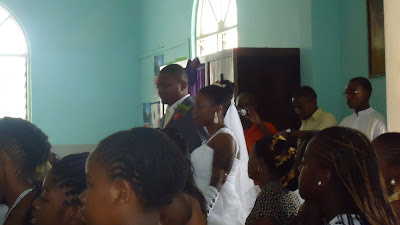Saturday I had yet another unique cultural experience. I was able to attend a Kenyan wedding here in Mombasa last.
 |
| Grace and Yieri |
One of the girls I’m living with invited us all to attend the wedding of her host cousin. Actually, her host cousin’s cousin, but that sounds so complicated. We arrived an hour late to the ceremony, which started at 10, but that turned out to be for the best…it lasted until 1:30!
The service was conducted entirely in Kiswahili, so I understood next to nothing. It was still interesting to look at the elaborate outfits and headdresses donned by attendees. The music was good too…there was drumming and choir singing, and at a few points young girls dressed in traditional kikoyes danced down the aisle.
 |
| Young Taita dancers |
Just when we thought the service would be ending, the priest would call up another family member to say something, or he would add another short message, or he would perform another ritual. Soooo long to sit in a cramped church on a blazing hot day.
 |
| Our view of the wedding |
When the ceremony finally ended, we headed across town to the reception. We ate biryani rice, which I think is just rice cooked with spices and oil, with goat meat stew. We ate with our hands of course. The four of us shared two servings; it’s incredible how much food the serve here.
 |
| Reception grounds |
Interestingly, the wedding guests ate before the wedding party had even arrived at the reception facility. When they did arrive, they entered to music and the crowd greeted them with singing and dancing, escorting them to the head table in a parade-like fashion. They were served a more elaborate meal there as the guests sat and socialized.
 |
| Welcoming the wedding party |
We left before the cutting of the cake (they do it at the end so people will stick around) because we had to get back to work. We were told it was a pretty typical Kenyan wedding but that it had distinct coastal influences, both in the music and the food.
 |
| The four Mombasa-based SIT students and Yieri's host cousin, Samba |












































